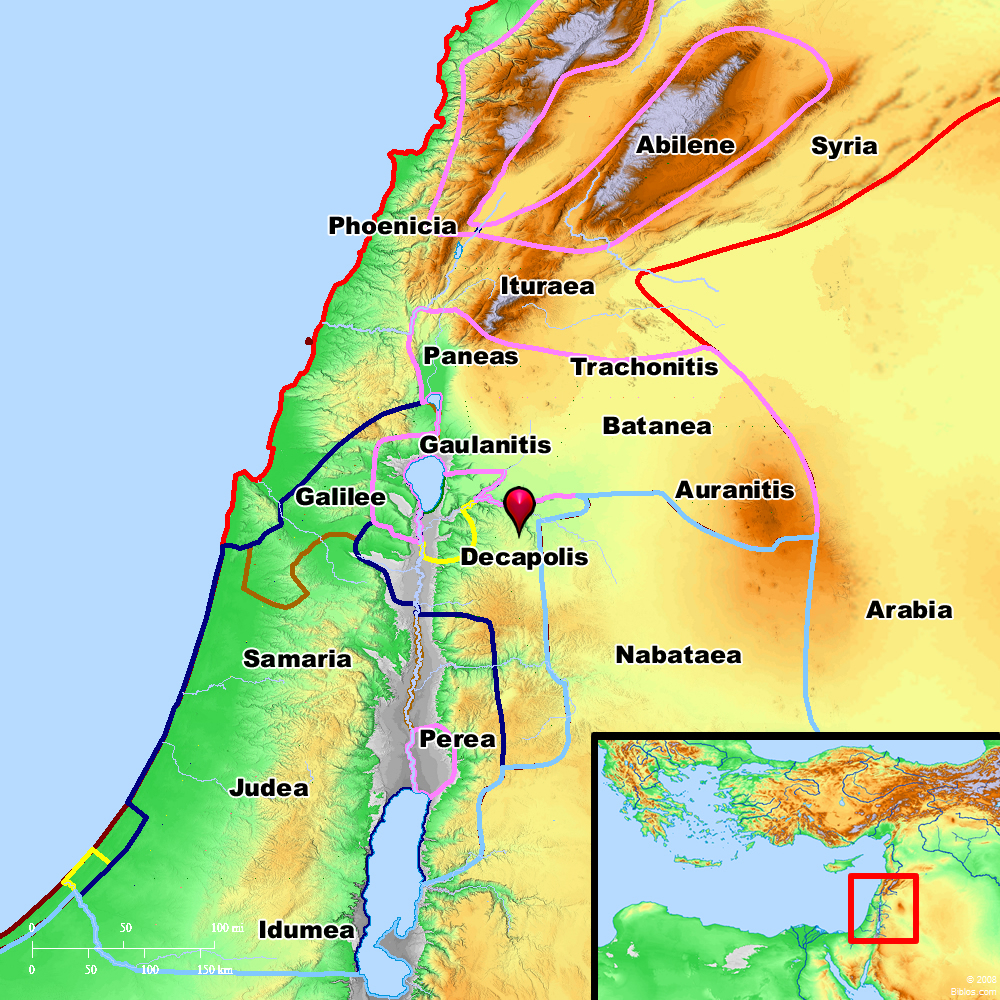Atlas

Decapolis and surrounding region
Maps Created using Biblemapper 3.0Additional data from OpenBible.infoOccurrences
Matthew 4:25 Great multitudes from Galilee, Decapolis, Jerusalem, Judea and from beyond the Jordan followed him.
Mark 5:20 He went his way, and began to proclaim in Decapolis how Jesus had done great things for him, and everyone marveled.
Mark 7:31 Again he departed from the borders of Tyre and Sidon, and came to the sea of Galilee, through the midst of the region of Decapolis.
Encyclopedia
DECAPOLISde-kap'-o-lis (Dekapolis): The name given to the region occupied by a league of "ten cities" (Matthew 4:25 Mark 5:20; Mark 7:31), which Eusebius defines (in Onomastica) as "lying in the Peraea, round Hippos, Pella and Gadara." Such combinations of Greek cities arose as Rome assumed dominion in the East, to promote their common interests in trade and commerce, and for mutual protection against the peoples surrounding them.
This particular league seems to have been constituted about the time of Pompey's campaign in Syria, 65 B.C., by which several cities in Decapolis dated their eras. They were independent of the local tetrarchy, and answerable directly to the governor of Syria. They enjoyed the rights of association and asylum; they struck their own coinage, paid imperial taxes and were liable to military service (Ant., XIV, iv, 4; BJ, I, vii, 7; II, xviii, 3; III, ix, 7; Vita, 65, 74). Of the ten cities, Scythopolis, the ancient Bethshean, alone, the capital of the league, was on the West side of Jordan. The names given by Pliny (NH, v.18) are Scythopolis (Beisan), Hippos (Susiyeh), Gadara (Umm Qeis), Pella (Fahil), Philadelphia (`Amman), Gerasa (Jerash), Dion (Adun?), Canatha (Qanawat), Damascus and Raphana. The last named is not identified, and Dion is uncertain. Other cities joined the league, and Ptolemy, who omits Raphans, gives a list of 18. The Greek inhabitants were never on good terms with the Jews; and the herd of swine (Mark 5:11) indicates contempt for what was probably regarded as Jewish prejudice. The ruins still seen at Gadara, but especially at Kanawat (see KENATH) and Jerash, of temples, theaters and other public buildings, attest the splendor of these cities in their day.
W. Ewing
DECAP'OLIS, a name meaning "ten cities," whose locations are not all certainly known, but their general region was e. and s. of the sea of Tiberias, as far as Damascus on the n. and Beth-shean on the s., including these cities.
Strong's Greek
G1179: DekapolisDecapolis, a region East of the Jordan




